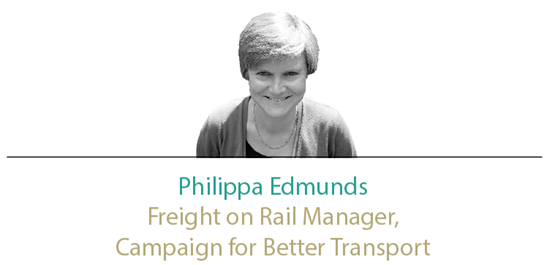
Anthony Lambert has written a cogent and comprehensive analysis of the Department for Transport’s Rail Freight Strategy and the outlook for the industry. I would like to emphasise the socio-economic benefits of rail freight to UK plc, and the resulting overwhelming case for affordable freight charges and network enhancements to satisfy suppressed demand.
Supporting rail freight is a great way for the Government to reduce road deaths, as HGVs are disproportionately involved in fatal road crashes because of their size and scale. The latest Government figures show that HGVs have been six times more likely than cars to be involved in fatal collisions on minor roads over the past three years. On motorways, in 2014 HGVs were involved in almost half (45%) of fatal collisions, although they accounted for only 11.6% of the miles driven on them.
Road congestion is damaging productivity, and cost industry £17 billion in 2015, according to the Freight Transport Association. The distance travelled by HGVs increased by 9% to 18.4 million vehicle kms last year. Nationally, half of the traffic from the largest HGVs (five-axle and above) is on trips of over 120 miles and a quarter of the largest over 180 miles, some of which could be captive to rail.
Figures for strategic corridors that have parallel rail lines emphasise this potential for modal shift. Daily flows of M6 corridor analysis show 9,500 of the largest HGVs on the route. On the A14 just outside Felixstowe, each day 4,863 out of a total of 5,632 HGVs (86%) are in the largest category. Removing even modest numbers of HGVs can reduce congestion significantly, because HGVs occupy considerably more road space than the average car, they need longer braking distances, and they are slower to manoeuvre and therefore cause more road congestion. DfT estimates the cost of congestion is 99 pence per lorry mile on the most congested motorways.
The Rail Freight Strategy recognises that increasing rail freight, which produces 76% less CO2 emissions than the equivalent HGV journey, will help the UK to meet its legally binding Climate Change targets. Surface transport emissions account for the vast majority (94%), and of that HGVs contribute 17% despite making up only 5% of road vehicles. Both passenger and freight rail together are less than 2%. Rail has the potential to save over 4.6 million tonnes of CO2 - a reduction of around 19% of total 2013 HGV emissions.
HGVs account for half of the nitrogen oxide road emissions on the Strategic Road Network, while making up only 5% of road miles driven in the UK. Thus rail, which produces almost 90% less PM10 emissions and up to 15 times less NOX emissions than HGVs, can help alleviate the air pollution crisis that is contributing to 50,000 early deaths and costing £27.5bn every year. Freight on Rail is campaigning for new comparative road/rail emissions research to be a key output from this strategy, on the grounds that Government policy decisions across all departments are currently being taken on outdated figures.
Rail has an established and expanding deep sea container freight market, which grew 7% last quarter compared with the same quarter in the previous year - the highest level since 1998. It has grown by 30% in the past ten years and is forecast to grow fourfold by 2043 if the network is upgraded and additional road/rail transfer points obtain planning permission. A quarter of the consumer goods imported into the UK are transported by rail, and this long-distance traffic is ideal for rail where there is suppressed demand, which can expand if there is more rail freight capacity on key corridors.











